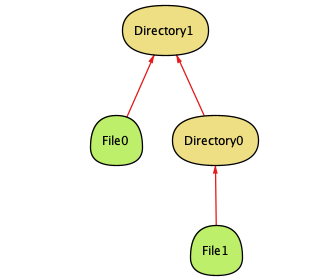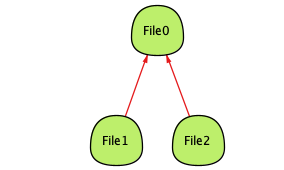give aliases when inverting relations
Brian Hicks, February 27, 2023
Say you're using Alloy to model some tree structure. For example, a file system with directories and files:
abstract sig Node {
parent: lone Node,
}
sig File, Directory extends Node {}
fact "a node cannot be its own parent" {
no n: Node | n in n.^parent
}
fact "there is only one root node" {
one n: Node | no n.parent
}
This gives us nice file system objects that always terminate in a single node and without any recursive shenanigans, like this one:

However, the model currently implicitly allows this that we don't want to include based on our mental model of the filesystem. For example, files that have other files as their parent:

That doesn't work: a directory can have children, but a file needs to have contents instead (e.g., images, text, etc.) So let's disallow that! We'll do that by adding a new fact like “files shouldn't have any children.” We could do that by saying this:
fact "files shouldn't have any children" {
no File.~parent
}
(In case you haven't encountered the ~ operator before, it just flips the relation. That makes it child-to-parent instead of parent-to-child. More about this in fields as sets)
Alloy can work fine with this, but in my opinion, using ~ like this makes the intent of the spec less clear. I always have to think about what the ~ is changing, even if I wrote the code not ten minutes before! Fortunately, we can clarify this by making an alias with a fun and then define our fact in those terms instead:
fun children: Node -> Node {
~parent
}
fact "files shouldn't have any children" {
no File.children
}
This seems much clearer to me; the assertion we're making reads almost exactly how we'd write it in English. I like that a lot! It makes communicating about the spec easier, both for me and for anyone else who ends up reading it.
In general, I'm finding that I really like to use funs to clarify my intent, or to put a durable label on some form of node. Doing this requires a little mindset shift from writing preds or facts, since funs have to yield a subset of data instead of a boolean, but in my experience it results in higher-quality communication!